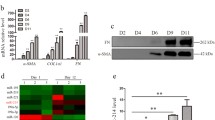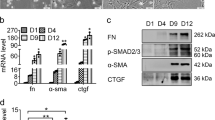Abstract
Background
Activated hepatic stellate cells (HSCs) are primarily involved in liver fibrosis and portal hypertension (PHT). We aimed to investigate the effect of miR-20b-5p on HSCs, liver fibrosis, and PHT.
Methods
MiR-20b-5p expression in HSCs and in mouse liver fibrosis was determined by qPCR. Further, the effects of miR-20b-5p mimic on HSCs migration, proliferation, and apoptosis were investigated in vitro. A dual-luciferase reporter assay was performed to confirm the direct interaction between miR-20b-5p and STAT3. In vivo, mouse liver fibrosis was established by common bile duct ligation and intervened by agomiR-20b-5p. Sirius red staining and hydroxyproline content were used to evaluate collagen deposition. The α-SMA expression in the liver was detected by IHC and Western blotting. The STAT3 signaling pathway and its downregulated cytokines as well as portal pressure and angiogenesis were explored.
Results
MiR-20b-5p was significantly downregulated during HSCs activation and in mouse liver fibrosis. The functional analyses demonstrated that miR-20b-5p inhibited cell proliferation, activation, and promoted apoptosis in HSCs in vitro. Moreover, miR-20b-5p regulated STAT3 expression by binding to the 3'UTR of its miRNA directly. Overexpression of miR-20b-5p facilitated HSC activation and proliferation by inhibiting the STAT3 signaling pathway. MiR-20b-5p overexpression suppressed the STAT3 and its downstream cytokines and ameliorated liver fibrosis in mice. The intra- and inter-hepatic angiogenesis were also effectively inhibited. The inhibition of liver fibrosis and neoangiogenesis contributed to the decrease of portal pressure.
Conclusions
MiR-20b-5p plays an important role in the fibrosis and angiogenesis of liver fibrosis by targeting the STAT3 signaling pathway.





Similar content being viewed by others
References
Friedman SL. Evolving challenges in hepatic fibrosis. Nat Rev Gastroenterol Hepatol 2010;7:425–436.
Liu L, You Z, Yu H et al. Mechanotransduction-modulated fibrotic microniches reveal the contribution of angiogenesis in liver fibrosis. NAT MATER 2017;16:1252–1261.
Ozturk AB, Storm G, Prakash J, Bansal R. Tyrosine kinase inhibitor BIBF1120 ameliorates inflammation, angiogenesis and fibrosis in CCl4-induced liver fibrogenesis mouse model. Sci Rep 2017;7:44545.
Cao G, Zhu R, Jiang T, Tang D, Kwan HY, Su T. Danshensu, a novel indoleamine 2,3-dioxygenase1 inhibitor, exerts anti-hepatic fibrosis effects via inhibition of JAK2-STAT3 signaling. PHYTOMEDICINE 2019;63:153055.
Wang D, Yin J, Dong R et al. Inhibition of Janus kinase-2 signalling pathway ameliorates portal hypertensive syndrome in partial portal hypertensive and liver cirrhosis rats. Dig Liver Dis 2015;47:315–323.
Nunez LO, Bohanon FJ, Wang X et al. STAT3 inhibition suppresses hepatic stellate cell fibrogenesis: HJC0123, a potential therapeutic agent for liver fibrosis. RSC Adv 2016;6:100652–100663.
Papageorgiou SG, Kontos CK, Tsiakanikas P et al. Elevated miR-20b-5p expression in peripheral blood mononuclear cells: a novel, independent molecular biomarker of favorable prognosis in chronic lymphocytic leukemia. Leuk Res 2018;70:1–7.
Luo Y, He J, Tao X et al. miR20b negatively regulates VEGF expression by targeting STAT3 in H22 hepatocellular carcinoma cells. Oncol Rep 2018;40:2806–2813.
Tang B, Bao N, He G, Wang J. Long noncoding RNA HOTAIR regulates autophagy via the miR-20b-5p/ATG7 axis in hepatic ischemia/reperfusion injury. GENE 2019;686:56–62.
Singh AK, Rooge SB, Varshney A et al. Global microRNA expression profiling in the liver biopsies of hepatitis B virus-infected patients suggests specific microRNA signatures for viral persistence and hepatocellular injury. Hepatology 2018;67:1695–1709.
Wang D, Wang Q, Yin J et al. Combined administration of propranolol + AG490 offers better effects on portal hypertensive rats with cirrhosis. J Gastroenterol Hepatol 2016;31:1037–1044.
Xiang DM, Sun W, Ning BF et al. The HLF/IL-6/STAT3 feedforward circuit drives hepatic stellate cell activation to promote liver fibrosis. GUT 2018;67:1704–1715.
Cummins CB, Wang X, Nunez LO et al. Luteolin-mediated inhibition of hepatic stellate cell activation via suppression of the STAT3 pathway. Int J Mol Sci 2018;2018:19.
Parola M, Pinzani M. Liver fibrosis: pathophysiology, pathogenetic targets and clinical issues. Mol Aspects Med 2019;65:37–55.
Kagan P, Sultan M, Tachlytski I, Safran M, Ben-Ari Z. Both MAPK and STAT3 signal transduction pathways are necessary for IL-6-dependent hepatic stellate cells activation. PLOS ONE 2017;12:e176173.
Duan B, Hu J, Zhang T et al. miRNA-338-3p/CDK4 signaling pathway suppressed hepatic stellate cell activation and proliferation. BMC Gastroenterol 2017;17:12.
Tao L, Xue D, Shen D et al. MicroRNA-942 mediates hepatic stellate cell activation by regulating BAMBI expression in human liver fibrosis. Arch Toxicol 2018;92:2935–2946.
Li Y, Chen D, Jin L et al. MicroRNA-20b-5p functions as a tumor suppressor in renal cell carcinoma by regulating cellular proliferation, migration and apoptosis. Mol Med Rep 2016;13:1895–1901.
Hong S, Yu S, Li J et al. MiR-20b displays tumor-suppressor functions in papillary thyroid carcinoma by regulating the MAPK/ERK signaling pathway. Thyroid 2016;26:1733–1743.
Tang LY, Heller M, Meng Z et al. Transforming growth factor-beta (TGF-beta) directly activates the JAK1-STAT3 axis to induce hepatic fibrosis in coordination with the SMAD pathway. J Biol Chem 2017;292:4302–4312.
Yoshiji H, Kuriyama S, Yoshii J et al. Vascular endothelial growth factor and receptor interaction is a prerequisite for murine hepatic fibrogenesis. Gut 2003;52:1347–1354.
Deng YR, Ma HD, Tsuneyama K et al. STAT3-mediated attenuation of CCl4-induced mouse liver fibrosis by the protein kinase inhibitor sorafenib. J Autoimmun 2013;46:25–34.
Sallam AM, Esmat A, Abdel-Naim AB. Cucurbitacin-B attenuates CCl4-induced hepatic fibrosis in mice through inhibition of STAT-3. Chem Biol Drug Des 2018;91:933–941.
Tripathi DM, Hassan M, Siddiqui H et al. Cirrhotic endothelial progenitor cells enhance liver angiogenesis and fibrosis and aggravate portal hypertension in bile duct-ligated cirrhotic rats. Front Physiol 2020;11:617.
Wang Z, Li J, Xiao W, Long J, Zhang H. The STAT3 inhibitor S3I–201 suppresses fibrogenesis and angiogenesis in liver fibrosis. Lab Invest 2018;98:1600–1613.
Wang Q, Zhang F, Lei Y, Liu P, Liu C, Tao Y. microRNA-322/424 promotes liver fibrosis by regulating angiogenesis through targeting CUL2/HIF-1alpha pathway. Life Sci 2021;266:118819.
Tsuchida T, Friedman SL. Mechanisms of hepatic stellate cell activation. Nat Rev Gastroenterol Hepatol 2017;14:397–411.
Iwakiri Y, Trebicka J. Portal hypertension in cirrhosis: pathophysiological mechanisms and therapy. JHEP Rep 2021;3:100316.
Coulon S, Heindryckx F, Geerts A, Van Steenkiste C, Colle I, Van Vlierberghe H. Angiogenesis in chronic liver disease and its complications. LIVER INT 2011;31:146–162.
Saab S. Portal Hypertension. Clin Liver Dis 2019;23:13–14.
Iwakiri Y, Shah V, Rockey DC. Vascular pathobiology in chronic liver disease and cirrhosis - current status and future directions. J Hepatol 2014;61:912–924.
Gao JH, Wen SL, Feng S et al. Celecoxib and octreotide synergistically ameliorate portal hypertension via inhibition of angiogenesis in cirrhotic rats. Angiogenesis 2016;19:501–511.
Pun CK, Huang HC, Chang CC et al. Glycyrrhizin attenuates portal hypertension and collateral shunting via inhibition of extrahepatic angiogenesis in cirrhotic rats. Int J Mol Sci 2021;22:1.
Funding
The study was supported by the National Natural Science Foundation of China (No. 81700533), the Key Research and Development Program of Shaanxi Province, China (Nos. 2017SF-116, 2015JM8420, 2015KTCL03-05), and the Innovation and Development Foundation of Tangdu Hospital (Nos. 2017LCYJ003, 2018JSYJ010, 2019LCYJ005).
Author information
Authors and Affiliations
Corresponding author
Ethics declarations
Conflict of interest
The authors declare that there is no conflict of interest with respect to this manuscript
Additional information
Publisher's Note
Springer Nature remains neutral with regard to jurisdictional claims in published maps and institutional affiliations.
Rights and permissions
Springer Nature or its licensor holds exclusive rights to this article under a publishing agreement with the author(s) or other rightsholder(s); author self-archiving of the accepted manuscript version of this article is solely governed by the terms of such publishing agreement and applicable law.
About this article
Cite this article
Lv, L., Wang, D., Yin, J. et al. Downregulation of miR-20b-5p Contributes to the Progression of Liver Fibrosis via the STAT3 Signaling Pathway In Vivo and In Vitro. Dig Dis Sci 68, 487–496 (2023). https://doi.org/10.1007/s10620-022-07660-z
Received:
Accepted:
Published:
Issue Date:
DOI: https://doi.org/10.1007/s10620-022-07660-z




